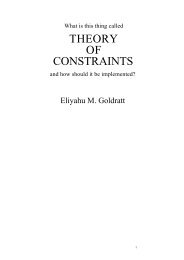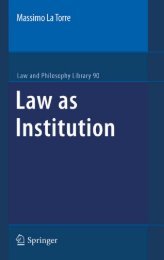Making of a German Constitution : a Slow Revolution
Making of a German Constitution : a Slow Revolution
Making of a German Constitution : a Slow Revolution
Create successful ePaper yourself
Turn your PDF publications into a flip-book with our unique Google optimized e-Paper software.
Last Bastion • 195be equal, as their functions were not equal, but different. Bismarck was fascinated bythe English parliamentary system, and it <strong>of</strong>fered an example <strong>of</strong> separation <strong>of</strong> powers.Given Bismarck’s hand in the growth <strong>of</strong> conservatism, there is cause for caution,but it is worth keeping in mind that in the face <strong>of</strong> an obstinate Wilhelm II, Bismarckwrote that ‘after experiencing how difficult ruling monarchs made it for their ministersto serve the country, one could almost become a republican’. 33Whether or not Bismarck was transformationist-minded or not, constitutionaltransformation was aided by his early cooperation with National Liberals in installingthe constitutional and legal avenues for the gradual formation <strong>of</strong> a representativestate. The key to transformation was the Bundesrat and Reichstag’s acquisition <strong>of</strong>Kompetenz-Kompetenz, as noted, in the early twentieth century, by Paul Laband andHeinrich Triepel amongst others. 34 Accordingly, the only distinction the constitutionmade between ordinary legislation and constitutional amendments was that the lattercould be defeated by fourteen negative votes in the Bundesrat. Kompetenz-Kompetenzallowed that no statute passed by the Bundesrat and the Reichstag could later bepronounced unconstitutional whether or not it conformed to, altered or amendedthe constitution. The Bundesrat and the Reichtag held the power to extend the competence<strong>of</strong> the Reich by simple legislation, and as a result there were significantchanges to the constitution over time. While some <strong>of</strong> these changes were ‘formallywritten into the constitution’ such as the Lex Miquel-Lasker, ‘most were not’. 35 Thisis where Jellinek drew the distinction between constitutional amendment, a ‘changein the text through a purposeful act <strong>of</strong> will’, and constitutional transformation, ‘achange that allows the text to remain formally unchanged and is caused by facts thatneed not be accompanied by an intention or awareness <strong>of</strong> the change’. 36As Reichstag deputies and members <strong>of</strong> the Bundesrat were no doubt well aware,the 1871 <strong>Constitution</strong> <strong>of</strong> the <strong>German</strong> Empire was flexible, and it did not confirmthe supremacy <strong>of</strong> the monarchical principle. An indication <strong>of</strong> this was discerniblein the written <strong>Constitution</strong>’s silences and the order <strong>of</strong> priority <strong>of</strong> its construction. Itfirst sought to establish the Reich’s geographical boundaries and, then, in the discussion<strong>of</strong> legislation, essentially the Reich’s jurisdiction. It also addressed the realm <strong>of</strong>the Bundesrat, and not until section four did the question <strong>of</strong> the imperial <strong>of</strong>fice becomethe main subject. Article 11 specifically stated that ‘the King <strong>of</strong> Prussia shall hold thePräsidium (presidency) <strong>of</strong> the Bund, and shall have the title <strong>of</strong> <strong>German</strong> Emperor’. 37Even a strict constructionist interpretation would have held that the King <strong>of</strong> Prussiawas only the president <strong>of</strong> the confederation. His kingship was tied to Prussia aloneand emperor was merely a name devoid <strong>of</strong> any constitutional authority. ‘The Reich<strong>Constitution</strong> <strong>of</strong> 1871 did not renew the universal imperium <strong>of</strong> the Holy RomanEmpire’; rather, as Ernst Huber wrote some time ago, the old notion <strong>of</strong> the ‘Emperor<strong>of</strong> the <strong>German</strong>s’ evolved into a conception <strong>of</strong> an imperial <strong>of</strong>fice as a symbol <strong>of</strong> nationalintegration and ‘an institution whose legitimacy and authority was based onthe common consciousness <strong>of</strong> the nation’. 38 ‘The Reich’, as such, ‘was a democracyand monarchy at the same time’. 39 It aimed to install the democratical, aristocratical




